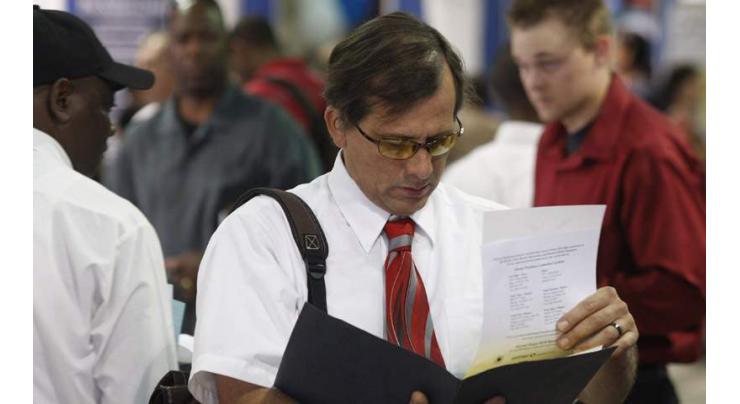
US Unemployment Lowest In 9 Years As Job Creation Continues
Rukhshan Mir (@rukhshanmir) Published December 02, 2016 | 09:40 PM

WASHINGTON, Dec 2, (APP - UrduPoint / Pakistan Point News - 02nd Dec, 2016 ) - The US unemployment rate in November fell to its lowest level since August 2007 as the economy continued to add new jobs, all but guaranteeing an interest rate hike this month.
The jobless rate fell an unusually large three-tenths to a surprising 4.6 percent, the Labor Department reported Friday. A solid 178,000 net new positions were created, in line with analysts' expectations.
The economy has added jobs at an average rate of 180,000 a month so far this year, a healthy pace but below the 229,000 rate in 2015. The big drop in the unemployment rate was a shock as it had moved little over the prior year.
The number of people in the workforce -- the labor force participation rate -- was also little changed at 62.7 percent. Private firms added 156,000 in the latest month, with continued gains in construction, healthcare and leisure.
However manufacturing firms lost jobs again in November, for a drop of 15,000 over the past three months, and retail fell slighty, unusual at a time when stores are adding seasonal workers for to deal with holiday shopping.
The share of long-term unemployed, or those seeking work for 27 weeks or more, was stable at 1.9 million, or 24.8 percent of the all unemployed people. Temporary work also increased again, and has added over 55,000 jobs in the past three months, but could be a sign companies are having trouble filling positions.
"With qualified workers in short supply, temporary help firms are once again doing a decent business," Joel Naroff of Naroff Economic Advisors wrote in a client note. The latest picture of the US economy's health comes President-elect Donald Trump touts his efforts to prevent job losses in the manufacturing sector by striking deals to reduce the off-shoring of jobs and warning companies considering relocating abroad of "consequences." Trump will assume office with unemployment at pre-recession levels that may be difficult to sustain.
- Full employment - =================== In a statement, the White House economist Jason Furman hailed the creation of 15.
6 million positions since 2010 and the longest streak of continuous job gains on record.
He also noted that the number of unemployed workers per job opening stood at 1.4, near its lowest pre-recession level. The unemployment rate is well below what monetary policymakers generally consider "full employment," which has created concerns that inflation is imminent, though there have been only modest signs of price pressures.
Naroff pointed to the various unemployment rates the Labor Department reports, including the broadest, and said, "All measures are near or at full employment." In another sign that inflation is tame, average hourly earnings declined 0.1 percent, or three cents, to $25.89, the first drop in wages since December 2014.
October had seen a gain of 11 cents. Wages are nevertheless up 2.5 percent over the last 12 months, outpacing inflation. But Ian Shepherdson of Pantheon Macroeconomics, like other economists looking at the report, said that wage decline may have been impacted by a Calendar quirk.
Shepherdson said he was "very skeptical" of the uneven wage data, which can be distorted when the 15th of the month, a typical pay day, falls outside the survey period for the government employment report.
"The hit in November is quite large, relative to the prior trend, but is inside the bounds of previous experience," he said. Regardless, analysts agree that while there are some questions in the employment data, there is nothing worrisome enough to prevent the central bank from raising the key interest rate this month.
US monetary policymakers have repeatedly signalled that they are likely to increase the benchmark rate at the final meeting of the year December 13-14. Committee members had earlier been divided however on the danger posed by inflation and the timing of the next rate hike.
The Federal Open Market Committee refrained from enacting an expected course of rate hikes in 2016 for fear of interrupting a fragile recovery and in the absence of wage and price pressures.
Related Topics
Recent Stories

PTI to stage nationwide protests against alleged electoral frauds

Senate continues discussion on Presidential address to Joint Sitting of Parliame ..

Masood Khan calls for Pak-US cooperation for regional peace

Interior Minister starts Margalla Trail Patrol for security

Currency Rate In Pakistan - Dollar, Euro, Pound, Riyal Rates On 26 April 2024

Today Gold Rate in Pakistan 26 April 2024

ICC Womens T20 World Cup Qualifier, Match 2: Ireland Women open with Comfortable ..

Robinson, bowlers help New Zealand go 2-1 up against Pakistan

Shahzeb Chachar to hold khuli kachehri on April 26

Heatwave amid Israel's aggression in Gaza brings new misery, disease risk

Tourism must change, mayor says as Venice launches entry fee

Court adjourns Judicial Complex attack case till May 17
More Stories From World
-
Pilot seriously injured after vintage plane crash in Western Australia
17 minutes ago -
Iron ore futures close higher
27 minutes ago -
Tabloid head wanted to 'protect' Trump from salacious stories
27 minutes ago -
Kenyan rugby player turned TikTok star cooks to fight depression
37 minutes ago -
Guangdong carbon market closes higher
37 minutes ago -
Sugar futures close higher
37 minutes ago
-
Nuggets push Lakers to brink as Embiid's 50 points lead Sixers over Knicks
47 minutes ago -
China high-tech capacity exposes overcapacity mantra in green energy
57 minutes ago -
Golf: PGA Zurich Classic of New Orleans scores
1 hour ago -
Cybersecurity firm Darktrace accepts $5 bn takeover
1 hour ago -
Clean energy drives massive BHP takeover bid
2 hours ago -
Copper price tops $10,000 for first time in two years
2 hours ago